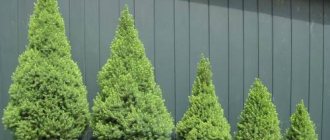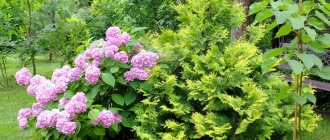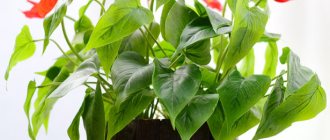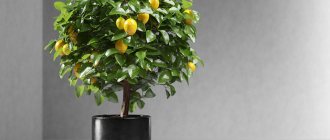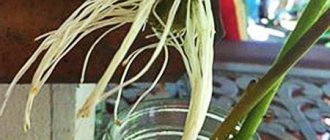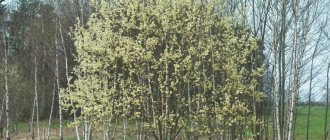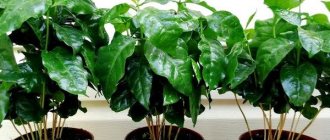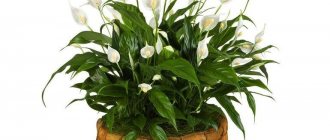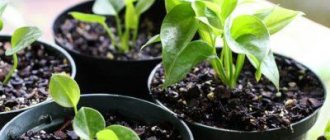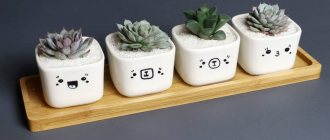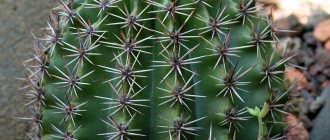Spruce
In nature, spruce is very tall and it will not be appropriate in every area. But thanks to the large selection of bred varieties with heights from 40 centimeters to 50 meters, anyone can choose the ideal option.
Before planting it, you need to consider the soil on which the spruce grows. When planting, a collection of leaf soil, turf, sand and peat is used. It is possible to buy ready-made soil for coniferous plants. The depth of the planting hole should be 50-70 cm, and it is also necessary to make drainage of at least 15 centimeters. When planting, do not compact the soil so that the root system can grow freely.
The spruce does not need feeding, but it would not be a bad idea to fertilize it in early spring, before the shoots have yet begun to grow. Some varieties need to be watered regularly because they do not tolerate extreme heat.
What grass can benefit from shade and acidic soil?
Acidic soil is not a reason to refuse to plant a lawn. We need to find out what kind of grass grows under pine trees and other coniferous plants. Small grass prefers acidic soil:
1) Common oxalis;
2) Wintergreen round-leaved;
3) European weekday;
4) Maynik two-leaf;
5) Bentgrass shoots.
This grass is not picky about conditions, germinates well and is easy to care for. The first four types of grass are not really designed to create a nice and dense lawn, they are more of a self-seeding type that can grow under a Christmas tree.
What is good about bentgrass?
If you want to plant a lawn, but don’t know what kind of grass grows in acidic soil, then be sure to take a closer look at bentgrass.
This plant is low-growing and belongs to the grass family. After planting the seeds and forming a root system, the bentgrass grows into a lush, ten-centimeter bush, which over time itself “creeps” across the area in a fluffy and bright carpet.
Running bentgrass does not need to be pruned often, and sometimes it is not pruned at all. It prevents the growth of weeds, protects plant roots from frost, and the soil from lack of moisture and excessive insolation.
Pine
There are about a hundred varieties of pine. Among them there are both giants, 25 meters high, and dwarf varieties from 40 centimeters to several meters.
Pine trees can be planted in any type of soil - clay, sand, even swampy soil, but its growth in such a place will be slow. When planting in a hole up to 1 meter deep, add turf soil with sand, peat and clay. If the soil is heavy, then it is worth draining to avoid rotting of the root system.
The first two years after planting, pine trees need to be fertilized periodically. Later, there will be no need for this, since the layer of fallen needles will itself serve as a nutritious fertilizer. But most varieties do not need watering. They are drought-resistant, and the litter of fallen pine needles retains additional moisture.
Watering spruce
Watering is mainly required only for young trees. It is best to do it in the morning and not every day. By autumn, watering should be more intense in order to prevent the death of the plant in winter.
Grown plants do not need additional watering, as they tolerate even dry summer periods and wintering well. The root system of such trees grows deep into the ground and independently extracts nutrients and moisture from there.
But if the summer is too dry, spruce may require sprinkling. It will not only provide the necessary moisture, but also clean the needles from dirt and dust. It is better to sprinkle in the morning and evening hours no more than once every two days.
Fir
The variety of fir varieties, and there are about fifty of them, will allow anyone who wants to plant a coniferous plant on their plot to choose the best option. Among them there are both shrubs and trees, and the height varies from 50 centimeters to 8 meters. They grow best in shaded areas.
For planting, a hole about half a meter deep is dug; if the soil is heavy, then a drainage layer of 20 centimeters must be made. Add leaf soil or humus, sand with peat and clay to the hole, or pour ready-made soil for coniferous plants from a bag.
There is no need to fertilize fir for the first 2-3 years after planting. Then you can use vermicompost for feeding. What it is and how to use it can be read below. There is no need to water the fir if the choice is not for a moisture-loving variety, while others need to be watered 2-3 times per season.
Planting and caring for spruce in open ground
Spruce can be planted in the ground in spring and autumn. Most gardeners prefer to do this in the spring so that the sprout has time to take root and gain strength before wintering. Despite the fact that spruce is a frost-resistant plant, young shoots may not be able to withstand too harsh a winter. However, it is in the fall that the spruce roots grow most actively, and the plant gains strength for the winter.
When replanting a spruce into the ground, you should take into account the location of the tree branches. As a rule, there are slightly fewer of them on the north side than on the others, so you need to replant the spruce this way - with the north side facing north.
Planting and caring for spruce in open ground is quite simple. It is better to prepare the soil for planting the crop in advance. To do this, a fairly deep hole is dug in a summer cottage, about half a meter deep for one-year-old sprouts, and about a meter for 2-3 year old trees from nurseries. Crushed stone or stones are poured into the hole to drain the roots, then a bucket of compost and universal mineral fertilizers.
Spruce is usually transplanted together with a lump of earth. Many nurseries sell seedlings in a metal mesh, through which roots can easily grow, and such a mesh does not need to be removed.
Juniper
One of the lowest types of conifers with a height of 50 centimeters to 5 meters. Trimming the crown allows you to make them of different shapes, and due to the fact that they grow rather slowly, you will not have to do this very often. Juniper should be planted in an open place so that the sun always illuminates it.
He likes soil made from peat, sand and turf. For planting, dig a hole 50-70 cm deep and make a drainage layer of 15 centimeters, but no less.
Fir should be fertilized no more than once a month with organic fertilizers, such as vermicompost, but only if it grows more slowly than it should. Water it about once a month during dry summers. It is also advisable to spray fir needles once a week early in the morning or in the evening, when the sun's activity is not very strong.
“An indoor Christmas tree in a pot is a very profitable investment! It looks beautiful, is not expensive, lives long, and grows slowly. I bought it once and provided my New Year holidays with a real live tree for many years” - that’s exactly what one of my friends thought and last New Year he gave me a Canadian spruce, the Konik variety. How to make Christmas tree decorations with your own hands.
Indeed, on New Year's Eve, garden and shopping centers, flower shops and supermarkets offer various options for live Christmas trees in pots, both with and without New Year's decorations. And after the holidays, unfortunately, most of these specimens end up in the trash with dry soil, yellowed and crumbling needles.
In fact, a Christmas tree can easily be grown at home if you provide it with suitable living conditions and regular care.
General information
Konika - a variety of Canadian spruce or gray spruce - is an evergreen coniferous tree of the pine family. It came to us from North America and is currently cultivated as an ornamental plant. It is successfully grown in marine, continental and temperate climates. A fairly drought-resistant plant and not picky about the soil. Not afraid of winds. It has high winter hardiness: it can withstand short-term temperature drops to -30 °C, but the optimal maintenance temperature is from +18 to -5 °C. It grows very slowly, at the age of ten it reaches a height of about 1 m. The young needles are light green in color and darken over time. The length of the needles is 10-15 mm. The buds are small and brown in color.
The plant is very light-loving. South windows are suitable for it, but it also feels good on the west or east side. When there is enough light, the needles grow thick and lush. If there is insufficient lighting, the gaps between the needles increase, and the branches and trunk look elongated.
Caring for the Christmas tree during the New Year holidays.
So, you have a live Christmas tree in a flower pot in your apartment. Place it on the brightest windowsill. If this is not possible, provide additional lighting for 8-9 hours a day. A table lamp will do just fine.
Spruce does not like drying out or waterlogging of the soil. Watering the plant should be regular but moderate. It is better to water the tree with settled water at room temperature, when the surface of the soil has already dried by 2-3 cm, but has not dried out and has not begun to crack.
You can determine the frequency of watering experimentally using a wooden stick, lowering it a couple of cm into the soil and leaving it there for an hour. If, after pulling out the stick, its tip is wet, it is too early to water the plant. I water the conic once every 3-4 days, depending on changes in air humidity, which is affected by sunny or rainy weather outside. Your watering schedule may differ from mine by 1-2 days.
Water is poured into the pot slowly, in a circle, until it begins to seep into the drainage holes at the bottom of the pot. After about 15 minutes, when all the excess water has drained into the pan, it needs to be drained. The Christmas tree does not tolerate soaking of the roots, which can begin to rot due to excess moisture.
In winter, the air in enclosed spaces becomes dry due to the central heating system or various heating devices. Moreover, the higher the air temperature, the drier it is. Too hot and dry air in the apartment can cause conic needles to dry out and fall off. To eliminate this problem, it is enough to spray the plant 1-2 times a day with settled water at room temperature.
By the way, spraying achieves not only moistening, but also cooling of the needles. When a liquid evaporates from a surface, its temperature decreases due to the fact that molecules with greater kinetic energy leave it. The liquid molecules remaining on the surface have less kinetic energy, move less, their temperature is lower, and therefore they cool the surface on which they are located. I will no longer burden you with physical and chemical processes. Just remember how cool you felt after swimming in a river, lake, pond or sea on a hot summer day. The Christmas tree feels about the same after spraying. Also, with frequent spraying, the time between watering increases, thus you can save some water.
When the holiday season is over, carefully remove all holiday decor from the tree. If the branches have been sprayed with artificial snow or glitter, it must be washed off! Cover the surface of the pot tightly with a plastic bag or stretch film to prevent excess water from getting into the soil, and rinse the needles thoroughly in the shower, placing the plant in a horizontal position.
Konica is an actively breathing plant; it requires a lot of fresh air. Even regular airing of the room will not help. So forget about the phrase “indoor Christmas tree.” The only place in the apartment where the Christmas tree will survive is a loggia or balcony, preferably not glazed; in extreme cases, glazed, but not insulated and constantly ventilated.
Wintering the Christmas tree
Like any plant, spruce has a growth phase and a dormant phase. When a plant rests, most of its physiological processes are suspended, while some processes stop completely. The plant’s body practically does not function; it gains strength for further growth.
The resting phase occurs during the winter period. But in order for the tree to “fall asleep”, it needs sub-zero temperatures. This is another reason why she should live on the balcony and not in the room.
Despite the fact that coniferous trees are frost-resistant plants, a Christmas tree in a flower pot in winter runs the risk of complete freezing of the earthen clod, when at sub-zero temperatures the soil moisture turns into ice and the soil itself hardens. This can lead to freezing of the roots. If, when the temperature drops, the needles themselves prepare for winter, then the root system of the conic needs to be additionally prepared - covered.
There are many different ways to cover plants for the winter. I use one of the simplest ones. At the bottom of a flower pot with a slightly larger diameter than the pot in which the conic is planted, I add tree bark, perlite or vermiculite. If there are drainage holes in the pot, they need to be covered so that the insulation does not spill out. I place the plant in the pot and completely cover it with insulation. With the onset of spring, when the night temperature rises to above zero, the tree can be removed from a large pot.
In winter, the number of irrigations and the volume of water used for irrigation are significantly reduced. In my conditions, watering is carried out no more than once a week, I just lightly moisten the surface of the soil, and when it’s frosty, I don’t water the plant at all. And no spraying. From the beginning of spring until late autumn, when the plant is actively growing, the frequency of watering increases, and when the air temperature is above 18 °C, we resume regular spraying of the needles.
From the beginning of February, when the sunlight becomes brighter, the process of photosynthesis begins in the needles, which is accompanied by a large consumption of moisture. At the same time, the root system is still dormant and is not able to absorb moisture from the soil. As a result, the needles dry out, turn yellow and crumble, and the plant itself may die.
This phenomenon is called a sunburn. To avoid it, from the beginning of February to mid-March, the tree must be hidden from direct sunlight. Just move it deeper into the balcony, and from mid-March begin to gradually accustom it to bright light, daily increasing the time it is exposed to sunlight.
However, if you still get a burn, but no more than 40% of the crown is damaged, the tree can still be revived with growth stimulants, for example, Epin-Extra or Zircon, diluting them with water according to the instructions indicated on the package, and spraying the crown 2-3 times with an interval of 5-7 days.
Christmas tree fertilizers
From spring to autumn, it is advisable to feed the conic with fertilizers, then it will grow actively, will not get sick and will not be attacked by pests. A lot of fertilizers for conifers are now sold. Manufacturers include additional elements in their composition, supposedly for: balanced nutrition, preventing the loss of greenery, increasing resistance to adverse conditions, and so on. Sometimes you can read something on the packaging that makes you want to take these fertilizers instead of vitamins. In general, I think it’s all marketing. The main thing is that the fertilizer contains: nitrogen, phosphorus and potassium.
Shake the bottle well before using liquid fertilizer. Next, dilute the fertilizer with water in the proportions indicated on the package. First, lightly moisten the earthen ball with clean, settled water, and only then water the plant with a fertilizer solution. You can spray the needles with the remains of the diluted fertilizer, but it is not recommended to store the remains for later use, so if you need to fertilize just 1 tree, it is better to use a pipette instead of a measuring cap. The frequency of fertilizing mainly depends on the fertilizer used, as the manufacturer indicates on the packaging. As a rule, they fertilize the Christmas tree at least 2 times per season, maximum – once every 2 months, and it’s not worth it more often.
Christmas tree transplant
Coniferous plants in a flower pot, although slowly, grow, their roots grow into drainage holes, and the soil is depleted. Therefore, they periodically need a transplant. The tree can be replanted in early spring, before young needles appear, or in autumn, before the first frost.
The root system of spruce does not penetrate deep into the soil; its taproot practically stops growing vertically at the age of 2-3 years. At the same time, the tree’s lateral roots grow and branch horizontally. It is better to choose a pot for replanting that is not deep, 1-2 cm in diameter wider than the previous pot and must have drainage holes. To prevent stagnation of excess water, you need to additionally place a drainage layer on the bottom of the pot; a couple of centimeters of expanded clay will do.
The soil for the Christmas tree should have an acid index of 4-5 and allow moisture and air to pass through well. The soil composition should include high-moor peat, turf soil, river sand, perlite or vermiculite. I don’t bother with mixing different components, I just buy ready-made soil for conifers and additionally add perlite or vermiculite to it, since peat tends to dry out a lot, which does not have a very beneficial effect on the conic.
The roots of spruce lack root hairs, with the help of which other plants absorb water, mineral salts and nitrogenous substances. The role of root hairs in this case is played by thin threads of the fungus that entangle the ends of the roots. This phenomenon is called mycorrhiza or fungal root. Scientists believe that mycorrhizae are found in half of the species of European flora: trees, shrubs and herbaceous plants. Mycorrhiza was first described at the end of the 19th century by botanist Franz Mikhailovich Kamensky.
The death of mycorrhiza leads to the fact that the plant is not able to feed on its own and also dies, so it is not necessary to replant the conic often, once every 2-3 years using the transshipment method. A little new soil is poured into a new pot with expanded clay at the bottom. The tree is carefully removed from the old pot, after slightly cleaning the earthen ball along with the old soil, it is moved to a new pot. Fresh soil is added to the sides and top without deepening the plant's growing point.
After transplantation, the plant is watered. During watering, fresh soil settles slightly, so you need to add dry soil. To prevent the top layer of soil from drying out, you can mulch it - add tree bark.
If the plant is transplanted into purchased soil that contains minerals and trace elements, there is no need to fertilize the plant within a month after transplantation.
Crown formation
As a rule, conics naturally have a beautiful shape and do not require any crown shaping. However, if you do not like the appearance of the plant, it can be slightly adjusted.
Usually bonsai masters are engaged in shaping conifers. By the way, they have one important rule: before the formation begins, the plant after purchase must fully adapt to new living conditions. This adaptation lasts a year. That is, you can start forming the crown only when the plant has lived in your house for a year and is not sick.
To change the direction of growth of conic branches, you can apply a ligature to them - wind the wire, having previously secured it on the trunk at the base of the branch and wrap the branch at an angle of 45°, without touching the needles if possible. It is better to apply a ligature to conifers at the end of autumn, when the plant begins to enter the dormant stage. The wire should be soft, preferably made of non-ferrous metal or insulated, so that it does not rust when spraying the plant. The diameter of the wire should be about a third or a quarter of the thickness of the branch.
After winding the wire, the branch easily bends and is fixed in a new position. The plant remains in this state for 3 to 6 months. During this time, the branch gets used to the new position, after which the wire is cut off. While the wire is still on the branch, you need to make sure that it does not start cutting into the bark, especially starting from the end of winter. In this case, you need to cut it off and screw on a new one, a little weaker.
At the end of spring and beginning of summer, when the period of active sap flow ends, the plant requires sanitary pruning - removal of dry and diseased branches.
As the conic grows, it can reach a height of 2.5 meters and no longer fit in the apartment. To avoid this, in addition to sanitary pruning, you can pinch the shoots - trim the ends a couple of centimeters, without touching the needles below the cut. This will make the branches begin to branch better and become more luxuriant. To prevent the plant from suffering too much from pruning, no more than 15% of the crown can be cut off at a time. The tool must be sharp, clean and disinfected. After pruning, the plant can be sprayed.
Christmas tree diseases and pests
Most diseases of coniferous plants are of fungal origin. In the early stages, they are treated with simple treatments with fungicidal preparations.
A coniferous tree that is still weakened is susceptible to attack by insect pests. They can be overcome with the help of insecticidal preparations.
During treatment, it is better to remove the tree away from other plants until complete recovery, and treat it with fungicides and insecticides not only for treatment, but also as a preventive measure - once a year, in early spring.
With proper care, conika can live for more than three hundred years. Maybe one day your descendants, when decorating the New Year tree, will remember you with gratitude!
Larch
In nature, larches reach a height of 50 meters, which is unlikely to look harmonious in any area. However, the bred varieties with a height of 3-5 meters will look great on any personal plot. The best place for larch is an open and well-lit area.
When planting, use leaf soil, peat and sand, as well as ready-made soil. It is worth planting larch in a hole 50-70 cm deep, and if the soil is heavy, you need to make a drainage of 15 centimeters.
Fertilize it in the spring at the very beginning of the growing season. Larch is a moisture-loving plant, so it is better to mulch the soil with peat, sawdust or pine needles so that the soil is always moist, and in hot weather it should be additionally watered.
Soil for conifers and its composition, what kind of soil the plants need - we prepare the right substrate.
But if the root part is wrapped in polyethylene or burlap, then it is better to remove the shell so that the process of rotting does not begin in the soil. The soil around the trunk needs to be compacted a little so that there are no voids in the soil around the roots, and a little watering will be enough to lightly moisten the soil. Small seedlings can be covered with covering material, a cut bottle or film, as they will take root faster in such an improvised greenhouse. It will be possible to remove the film within a week, but the “greenhouse” needs to be ventilated daily.
When the spruce has been planted in the ground, and the spruce has taken root a little, the question of caring for the plants arises. Fertilizers added to the soil during planting will last for several years, so trees usually do not require fertilizing. It is much more important to water the tree correctly in the first few years of its life, since the growth rate of seedlings depends on the amount of moisture in the soil. It is recommended to fertilize only decorative dwarf varieties that are artificially bred and therefore weaker and less adapted to poor soils.
Every week, a grown plant needs about 15 liters of water.
It is not worth pouring out such an amount of moisture at once, so as not to wash away the soil; it is much better to divide the amount of water into two waterings.
Spruce responds positively to sprinkling, so if there is a drought and the tree has withered, it is recommended to water it with a hose with a sprinkler, and the plant will turn green again.
It is recommended to water a small annual spruce daily so that the soil remains slightly moist at all times.
The soil around the seedlings must be loosened regularly, since the roots of the tree need air flow. The soil will caking less and retain moisture longer if the soil around the trunk is mulched with mown grass or sawdust.
Like many other plants, spruce needs to be pruned and its green mass formed.
The plant reacts very positively to this procedure: after removing excess branches, the spruce begins to grow especially actively.
Experienced gardeners recommend forming the crown annually. In addition, spruce is often used for landscape design, in which a shape is cut out of a fluffy Christmas tree. Pruning spruce trees is also used to form a hedge: due to the trimmed top, the plant grows in width, its side branches lengthen and create a natural fence.
Preparing the planting hole
Once the type and variety of needles has been selected, it’s time to start planting. First, you need to decide on the place where to plant the plant. In this case, the future size of the plant must be taken into account so that it can easily grow both in height and width. The planting site must meet the necessary requirements of the selected variety and, of course, the soil for the coniferous plant must be prepared in advance.
First, a hole of the required depth for a particular type of coniferous plant is dug, approximately 2 times wider than the earthen clod. Part of the excavated soil can be left if it is quite loose and fertile. At the bottom, if the selected plant requires it, a layer of drainage is laid out; you can use broken brick, sand or gravel for this.
Before planting, the roots of the seedling should be dipped in water along with a lump of earth so that after transportation they are saturated with moisture. Then the plant must be lowered into the hole and be sure to make sure that it sits vertically. The hole should be filled with a pre-prepared substrate or soil for coniferous plants purchased at a specialized store.
After planting, a small ditch is dug around the hole and filled with plenty of water. As soon as all the moisture is absorbed, the ditch is covered with earth and mulched, but so that a small depression around the perimeter remains and prevents the plant from being flooded. Peat, freshly cut grass or humus can be used as mulch.
General recommendations on how to grow a Christmas tree at home: choosing a location and stages of planting a seedling
The root system of spruce is located on the surface, so the planting site should not be close to buildings - at least at a distance of 1.5-2 m, tall spruce trees - from 5 m or outside the yard. There should also be at least 2-2.5 m between seedlings. Spruce is not afraid of shade, but will grow slowly in it. Therefore, to grow a Christmas tree at home, choose a place with good lighting. But the seedling should not be constantly exposed to scorching rays, especially at noon. Partial shade is great.
Maintain distance between neighbors!
Stages of planting or transplanting a seedling:
- Pour 1-2 buckets of water into the hole to soften the soil.
- Place 15-20 cm of broken brick, crushed stone or gravel drainage at the bottom. The heavier the soil, the higher the drainage layer. Sprinkle some substrate on top.
- Place the root ball and cover with soil mixture. To avoid deepening the root collar, place a board at the level of the hole as a guide. If the seedling is placed deep, lift it a little and add more earth to the bottom. Do not compact the soil!
- But be sure to water the seedling with 10-20 liters of water to eliminate voids in the ground. To prevent water from spreading, make an earthen dump around the spruce or place a tire, slightly deeper into the ground. You need to add water gradually so that it has time to be absorbed.
- Afterwards, lightly compact the soil around the trunk and mulch to a depth of 5 cm. It is advisable to use parts of coniferous trees - pieces of bark, branches, cones, pine needles. This will keep moisture and heat inside the planting hole. The mulch should not touch the trunk! Next spring, the mulch is loosened with the soil to a depth of 5-6 cm.
Important: If the soil has settled, add more prepared soil mixture and generously water the plant.
A stick level will help you avoid deepening the root collar.
Advice : If you have heavy soil and the soil has been completely replaced, then it is better to plant the Christmas tree in a rigid package. So that there is no contact with the main ground. This will help retain nutrients inside the planting hole longer.
Planting a Christmas tree in hard packaging
Fertilizers for coniferous plants
Vermicompost is often used as fertilizer for conifers. Not all beginners in gardening know what it is and how to use it.
Vermicompost is an organic fertilizer of natural origin, which arose thanks to the waste products of earthworms. It contains many useful substances and microelements, which is why the bright and fluffy needles of plants are maintained.
This fertilizer can be purchased in the form of a concentrate or granules, which are easy to use. Since vermicompost is a 100% natural product, it can be used without fear of overdose. Diluted fertilizer should be applied not only for root feeding, but also to water the foliage and needles of plants. In this way, beneficial substances are absorbed faster, and a natural barrier against disease is formed on the surface.
Another advantage of vermicompost is its maximum harmlessness to the environment and humans, which cannot be said about inorganic fertilizers.
Reproduction of spruce
A variety of methods can be used to propagate spruce. Thus, for species-specific spruce trees, seeds are used; selection species are grown from cuttings with grafting. But the most popular method of propagation is branches. They can be cut in spring (late April), summer (mid-June or late August) and autumn (november). Picture 8. Tree propagation.
Branches from young trees, between 4 and 8 years old, take root best. It is necessary to cut them at the top of the crown, since such cuttings take root best. The optimal length of cuttings is from 10 to 25 centimeters.
How to properly care for a spruce
How to plant a Christmas tree at home - maintenance rules
If you want to grow a forest beauty at home, lovers of indoor plants should know that not all types of conifers are able to grow at home. Among the types of Christmas trees that can be grown indoors, gardeners identify the following:
- common spruce;
- silver spruce;
- araucaria or indoor spruce.
Lat. Picea
Each of the listed species is grown in a flower pot, subject to the necessary care of the plant.
Many people believe that spruces are unpretentious plants. This opinion is wrong. Growing well in natural conditions, the evergreen plant requires careful care when grown at home.
In order for the plant to develop properly and please the owner with its appearance, it is important to provide it with good lighting. The place in which the flower pot will be located should be warm and bright. At the same time, the spruce must be protected from direct rays of the bright sun.
Expert opinion
Yulia Yurievna
I have a large garden and vegetable garden, several greenhouses. I love modern methods of cultivating plants and mulching the soil, and I share my experience.
Ask a Question
When planting a Christmas tree at home, it is important to protect the ephedra from spring burns, just as when cultivating it in open ground. It is a common belief that plants suffer most from the sun in the summer, but for coniferous crops this is only half true. The most dangerous period in terms of burns occurs at the end of winter and beginning of spring. During the dormant period, processes inside the plant slow down, and practically no moisture is absorbed. Therefore, even a homemade Christmas tree can be dehydrated at the end of winter. If such a plant is exposed to the rays of even the mild March sun, this can cause the needles to turn yellow and fall off. To prevent this from happening, we recommend watering the crop with warm water, then the roots will quickly become saturated with moisture, and also placing a protective screen in front of the crop. Such a device should make the lighting diffuse, but quite abundant. It is also not worth keeping the crop in a too dark place, as this will affect its decorative effect. For best results, it is better to shade a homemade Christmas tree in a pot when the sun is most active, from 12.00 to 16.00. This lighting mode will not provoke stretching and exposing the shoots and will protect the sensitive crown from burns.
During the cold season, the room temperature should be quite cool. Experts recommend keeping the spruce indoors, the temperature of which will reach + 6-10ºC in winter.
It is important to note that the spruce will not die if it is placed in a room with a negative temperature. But at the same time, it is worth paying attention to the state of the earthen coma. Under no circumstances should it become too hard from freezing.
Types of fir trees
For those who decide to grow a Christmas tree at home, it is better to pay attention to such unpretentious and inexpensive species as common spruce or prickly spruce. Serbian spruce is very hardy, the dark green needles of which are illuminated with silver below.
When you click on the picture it will enlarge!
| Norway spruce | Prickly spruce |
| Serbian spruce | Serbian spruce |
There are dwarf spruce species: Canadian spruce Conica (the height of a ten-year plant is about 50 cm) or common spruce Nidiformis (30 cm), which can fit in an apartment, but their appearance is somewhat different from the traditional one.
| Canadian spruce Conica | Norway spruce Nidiformis |
